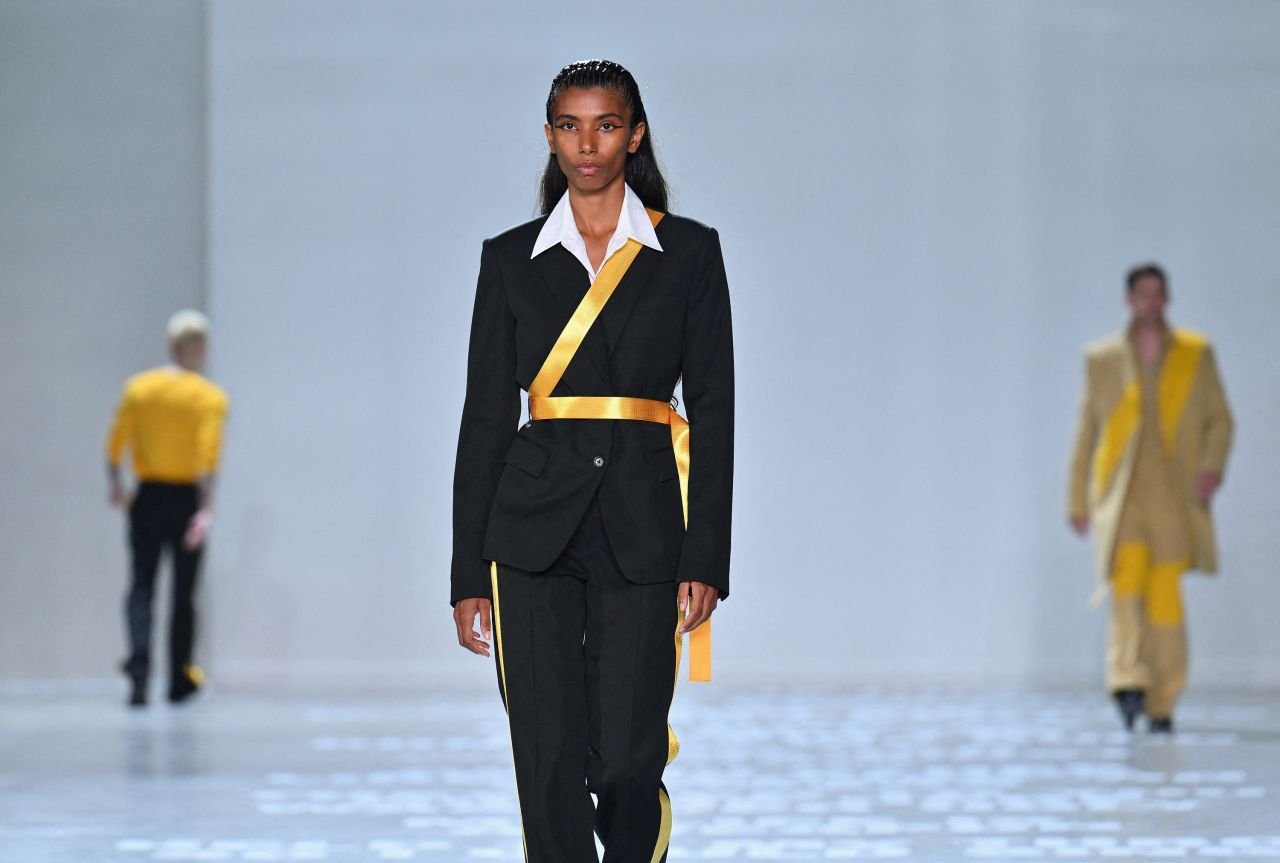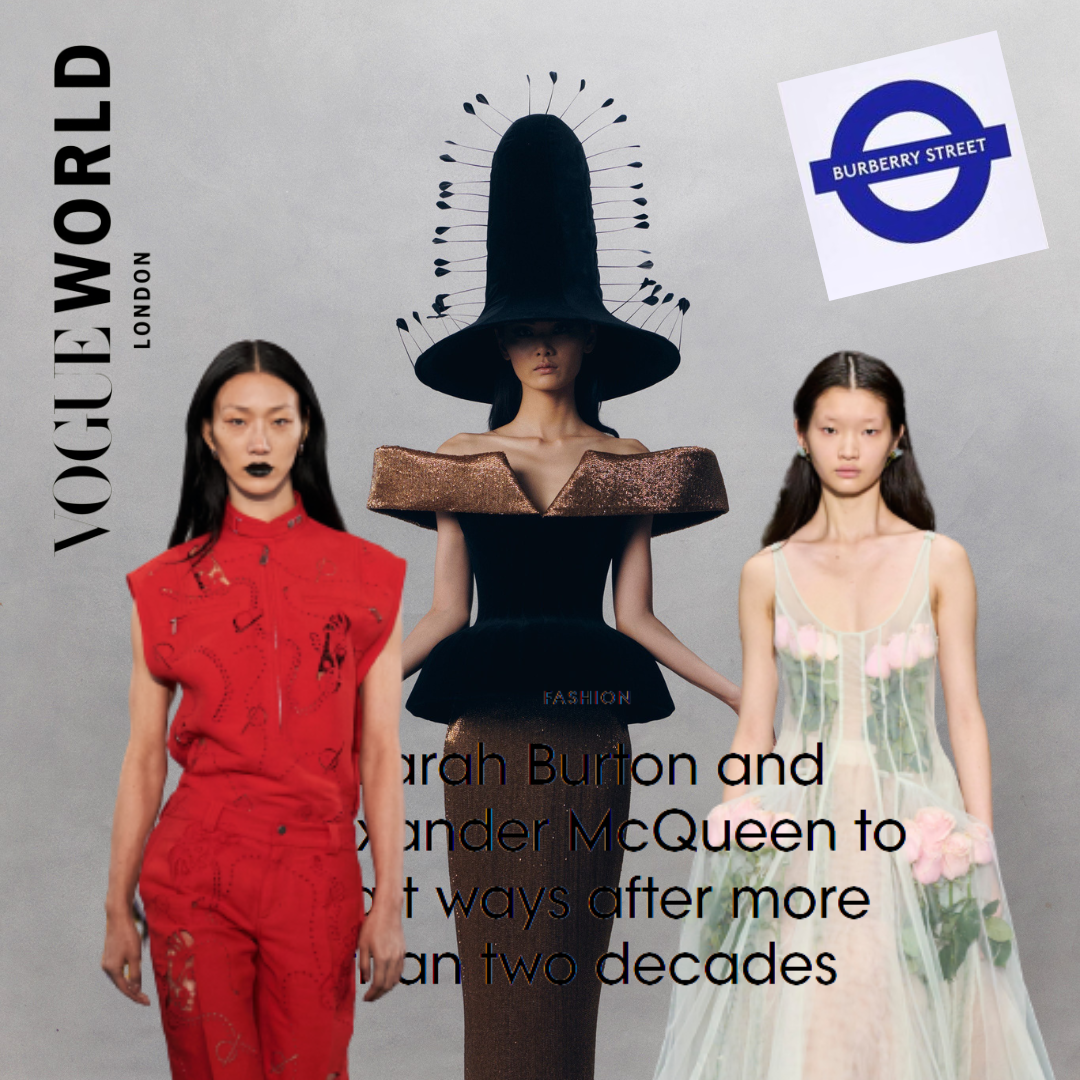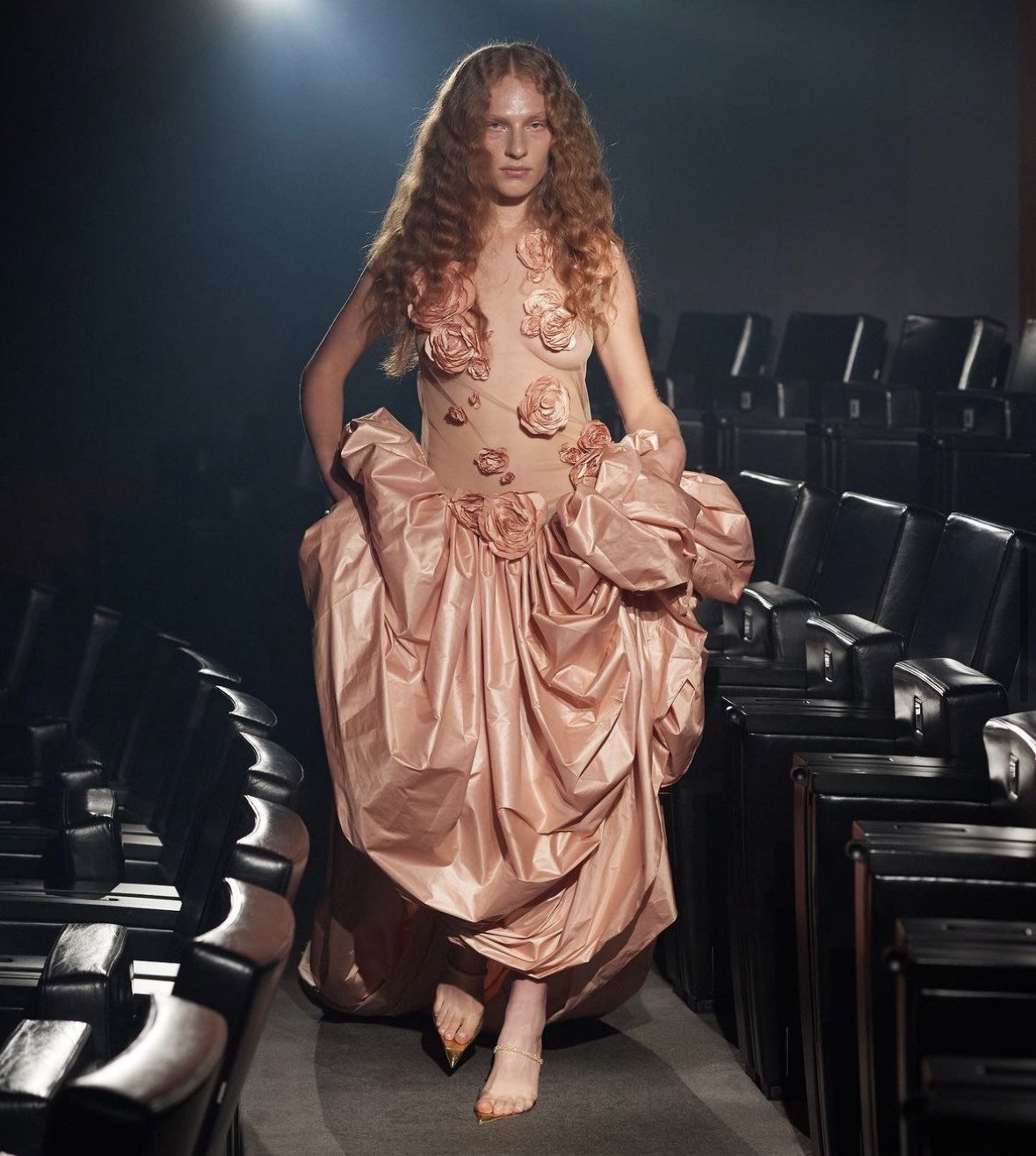Breaking & Healing: When Di Petsa Brought Mythic Performance Art to Fashion Week
With London fashion week once again around the corner, I'm taking a look at one of the best shows of last year. Di Petsa’s Persephone-inspired runway. Di Petsa is a UK-based designer whose designs have been worn by Kim Kardashian, Ashley Graham, Chloe Bailey, and Shakira. In her recent show at fashion week, inspired by the Greek myth of Persephone, Di Petsa created an explorative study of “Breaking and Healing”, creating a fashion underworld, with its queen as the figurehead.
There are mythic figures littered throughout the show, but the major recurring image is that of Persephone and her mythic story. The runway reflects Persephone’s suffering and metamorphosis, including her own transformation from maiden in the meadow, to queen of the underworld.
Motherhood
Di Petsa FW23
Image: Filippo Fior
The majority of Persephone’s story can be found in the Homeric Hymns, a collection of religious songs and stories from ancient Greece, but specifically the Homeric Hymn to Demeter, Persephone’s mother and the goddess of farming and agriculture, and they are often held up as the definitive mother/daughter duo of the gods. The role that motherhood played in Di Petsa’s show was huge, not only did she incorporate pregnant models (a demonstration that all bodies, including pregnant bodies, should be welcomed in the fashion industry) but she incorporated pregnancy into her other designs as well, confirming that Demeter and Persephone’s mother/daughter relationship was a theme within the show.
Looks 1, 3, 15, and 29 reflect this theme of motherhood. Look 1 opened the show barefoot with the pregnant model wearing one of Di Petsa’s iconic wet-look draped dresses, perhaps a play on the saying “barefoot and pregnant”, which implies women should be meek and submissive, staying at home with the children rather than going out to work. Demeter would go on in the myth to be anything but meek and submissive. Looks 3 and 29 continue the theme of motherhood, look 3 actually not featuring a pregnant model, but instead a model incorporating the bag by placing her arms around it in a gesture reminiscent of pregnancy. In both of these looks the model (Demeter) wore black. Grieving. This is because, as the hymn tells us, when Persephone is abducted by Hades whilst picking flowers in a meadow, Demeter believes her child has simply vanished without a trace. She grieves for Persephone and neglects the harvest, allowing it to wilt and die.
Look 15 perfectly encapsulates the feeling of Demeter, the model wore a dress with the shape of a baby bump incorporated, designed to accommodate a baby, empty. There is literally an empty space where her child should be.
This is the backdrop to Persephone’s story, the breaking apart of a mother and daughter. The myth of Persephone is too often portrayed in modern media as a love story [I blame Tumblr], when in reality the strongest love in the myth is the love of a mother and daughter, and the strength of each to recover from Persephone’s abduction and assault. Demeter learns of her daughter’s abduction and begins intentionally refusing harvests, allowing the world to die unless Persephone is released. Her grief and neglect of the world become the willful destruction caused by feminine rage. In terms of Breaking and Healing, this would be the beginning of the Breaking.
“She made a most terrible and cruel year for human beings…she would have destroyed utterly the mortal race of human beings” Homeric Hymn to Demeter
Maidens & Meadows
Di Petsa FW23
Image: Filippo Fior
Looks 14 and 18 represent Persephone as Kore, when she was the maiden gathering flowers in the meadow, who she was before Hades abducted her. Look 14 is youthful and golden, representing the Persephone of Olympus, daughter of Zeus, but the chain around her waist could reference the history of women's sexuality being “locked up” (like a chastity belt) until deemed appropriate by her father, which is ultimately what happened to Persephone (as it was Zeus who gave Hades permission to abduct Persephone, without consulting Persephone or Demeter). Since this is pre-abduction by Hades, her clothes are light and golden, with the headpiece similar to a delicate floral crown.
Look 18 was a simple dark grey/black dress with ripped details down the front and sides. The rips and tears would become more and more obvious as the show went on (an allusion to the violence in Persephone’s story) but what struck me about this look was the model’s hands. The model held flower petals tightly in both hands and halfway through the runway began to slowly let them fall, covering the floor in torn petals. This visualisation of a damaged flower scattered on the ground is beautiful and heartbreaking. It's small moments like this which blur the line between a fashion show and a piece of performance art.
The show also featured two child models in purple draped dresses, Grecian peplops style, with one child carrying flowers (look 6). In a follow-up Di Petsa referred to the two children as “Kore”, confirming that the children represent Persephone before her abduction.
Fellow Goddesses
Di Petsa FW23
Image: Filippo Fior
Looks 20, 28, 33, and 47 represent four fellow goddesses, each of whom encompasses feminine power in unique and different ways.
The first is the “snake goddess”. The model floated down the runway moving with the serpents, mimicking their motions, even reaching out to Di Petsa herself during the performance, a great example of how a runway is more than just a walk to show the designs, and how it can be transformed into a theatrical performance. I personally love this design because it reimagines two key features of The Minoan snake goddess. The famous statue of the goddess features a woman in a traditionally tiered Minoan dress (a priestess or goddess), exposing the figures’ breasts and wielding two writhing snakes. The model wore a bralette-esque band to mimic the low cut of the Minoan-style dress and carried two snakes, one in each hand. The Minoan snake goddess statue could reference a relatively unknown religious cult whose focus of worship was a mother goddess whose symbol was a snake. This image, the bare-chested woman holding two snakes, dates back nearly four thousand years, reimagined and brought back to life at London Fashion Week. In an Instagram post about this look Di Petsa also referred to the model as “Demeter'', so she's drawing deliberate parallels between the Minoan snake goddess and Persephone’s own mother, again reinforcing that strength in feminine relationships.
Look 28 is a simple black dress with the image of vines and flowers slowly creeping upwards, referencing Perspehones’ role as the goddess of flowers. However, the dress is detailed with figs and lilies, both symbols of Gaia, the primordial earth-mother goddess whose children were the Titans, the Giants and, basically, everything before the gods. She was ancient and a powerful force of nature, an example of a mother whose feminine rage could destroy the world. By incorporating subtle little images throughout the show Di Petsa demonstrated just how referential the tiny details in fashion can be. She would go on to do this again in the show with another fruit, the pomegranate.
The third goddess depicted in the show is look 33, where the model in blue walked the runway carrying two large bundles of sage, mimicking the image of Hecate with her two torches. Hecate is crucial to Persephone’s story because as the goddess of magic, witches and crossroads, she was often excluded from the pantheon. However, when Persephone was abducted by Hades she became an ally of Demeter against Zeus and Hades and when Persephone was forced to spend months in the underworld;
“From that time lady Hekate was her follower and friend”
In the context of Di Petsa’s theme, “Breaking and Healing”, Hecate is clearly placed as an example of the latter, this is only confirmed by the intentional replacement of the torches with a more recognisable symbol of healing: sage.
I think this transition from “maiden” to “queen of Hades”, follows the movement from one mother figure to another, and is confirmed by one of the many props laid out in front of Di Petsa herself during her performance. A piece of paper facing the audience read;
“My body is the soil from which flowers grow…
My body is the endless cave on which stalagmites form”
Moving from soil to cave, flowers to stalagmites, Demeter to Hecate, mother to witch, is Persephone’s journey of “Breaking and Healing”.
The final goddess is Nike. The closing look, with her draped grey “mourning” clothing, bears a striking resemblance to many depictions of winged Nike, particularly the famous statue “Winged Victory of Samothrace”. Nike was the goddess of victory and to close the show with her, dressed in funeral clothes, is a way to acknowledge Persephone’s new role and how powerful she has ultimately become; that she is victorious.
Bride of Hades
Di Petsa FW23
Image: Filippo Fior
Looks 2, 40, 41, and 46 all appear to be variations of bridal gowns, which point to the moment Persephone becomes the wife of Hades and queen of the underworld. I couldn't include all the wedding dresses in this collection because there were so many, so I chose a few of my favourites, but the “bridal” element of the runway is so prominent it's incredibly clear why Di Petsa has an entire bridal collection. The above looks have a wide range of styles and techniques to create clearly thematic, but distinctive dresses.
Look 2 is a classic Grecian style, one of the more wearable dresses in the collection but still using the iconic Di Petsa wet-look technique so that it appears the model just stepped out of the ocean. Looks 40 and 41 include subtle nods to Persephone’s new role in the underworld; look 40 carried a crystal, a reference to early jewels and treasures below the surface of the ground, and look 41 features a dress which when combined with Di Petsa’s wet-look appears to be melted silver, another precious metal associated with the underworld. Another look (not featured in this article) was Hades in a feminine style, and the model for Hades wore a necklace of dark crystals, which featured throughout the show, connecting these designs as husband/wife.
Hades was not only the god of death and the underworld itself, but also precious metals such as silver and gold, and amethyst were seen as having protective powers.
Finally, look 46 has a very traditional Greek silhouette, the veil and fabric slung over the model’s arm are similar to the dresses worn in vase paintings by the more religious, modest goddesses such as Hestia, and it brings the context of the show back to the ancient inspirations, amidst a sea of modern-day silhouettes and styles.
The Pomegranate
Di Petsa FW23
Image: Filippo Fior
Looks 13, 17, and 25 are the pomegranate looks. These show the various ways in which Di Petsa chose to incorporate the fruit, synonymous with the myth, into the runway.
In the myth Hades feeds a seed (sometimes it’s six, representing the six months she must spend with him each year) to Persephone after Zeus realised the danger in Demeter going all scorched earth and demanded Hades allow Persephone to go home;
“But he (Hades) stealthily gave her to eat a seed of the pomegranate, honey-sweet, furtively peering around him, so that she would not stay away forever”
“But secretly he spilled into my mouth a seed from a pomegranate, that honey-sweet food, and forced me, made me taste it against my will”
Homeric Hymn to Demeter
The sexual undertones of the “pomegranate seeds” is fitting with Di Petsa’s themes of womanhood and sensuality; we often cover sexual metaphors with food, nature, and implications. But Di Petsa presents the iconic historic image, the pomegranate, in an undeniably sexual context. Look 17 featured a model in a gold dress, torn and tattered, barefoot and holding a pomegranate. The pomegranate wasn’t intact, it had been torn open, which imbued a violent and uncomfortable note to the overall look. Taking the metaphor of the pomegranate and using it in an image which removes the quiet implication and shouts its meaning brings the story of Persephone, and of women throughout time, into harsh light. The Breaking aspect of Breaking and Healing.
The seeds themselves become part of the fashion in looks 13 and 25, in both instances being represented by red beads. In look 13 the model wore a torn, tan, leather corset dress (both structured and damaged, again this pattern of brokenness) with six red beads that resemble pomegranate seeds hanging from her mouth on a tiny chain, utilising delicate jewellery, which could be easily overlooked on a runway. This is repeated in look 25, where the model in a beautiful red greek inspired two-piece wore a necklace with gold all the way around, except for a small section at the front which sports six red beads. Again, the pomegranate (Hades’ sexual control over Persephone) may not be front and centre, but it is still very much present.
Di Petsa uses the myth of Persephone to express through her designs that womanhood and sexuality have always been so connected to being damaged in some way, historically, and yet rising above despite that. She uses her on this runway to show that historically women have often moved from “the maiden in the meadow” and “the victimised” to “the queen of the underworld” and “the bringer of death” through this powerful process of being broken and healing. The entire show can all be summed up in a few words from the homeric hymn;
“But whenever in spring the earth blossoms with sweet flowers of every kind, then you will rise again from the realm of dusk and darkness and be a source of great wonder for mortals and for gods”













